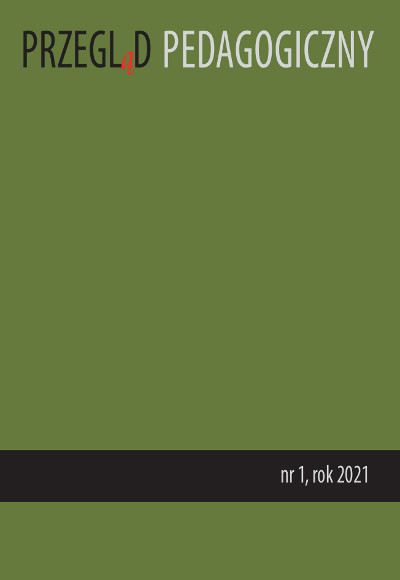Dyslexia – occurrence, definition issue and gender correlation
DOI:
https://doi.org/10.34767/PP.2021.02.07Keywords:
pedagogy, dyscalculia, dysgraphia, dyslexia, dysorthography, gender correlation, educational psychology assessment, specific reading and writing disorderAbstract
Dyslexia is a well-known disorder, which is often misunderstood or underestimated. Disputes of opinion concern the whole society as well as researchers who present their own definitions of specific reading and writing difficulties, pointing to different pathomechanisms and symptomatologies. This article presents the results of analyses of psychological and pedagogical
documentation: statistical data concerning the number of children with dyslexia, dysorthography, dysgraphy, dyscalculia on the example of students from a selected school in Cracow. Conclusions from the research turn out to be surprising both in terms of the number of students with disorders in relation to the averaged percentage ranges adopted in the literature, as well as the correlation between gender and dyslexia, which generally recognises boys as much more often affected by the aforementioned difficulties.
References
Bogdanowicz M. (2011). Ryzyko dysleksji, dysortografii i dysgrafii. Skala ryzyka dysleksji wraz z normami dla klas I i II. Gdańsk: Wydawnictwo Harmonia Universalis.
Bogdanowicz M. (2009). Fakty, mity i kontrowersje wokół diagnozy dysleksji. W: G. Krasowicz-Kupis (red.), Diagnoza dysleksji. Najważniejsze problemy. Gdańsk: Wydawnictwo Harmonia.
Bogdanowicz M. (1993). Specyficzne trudności w opanowaniu mowy pisanej: czytania i pisania. W: T. Gałkowski, Z. Tarkowski i Z. Zaleski (red.), Diagnoza i terapia zaburzeń mowy. Lublin: Wydawnictwo UMCS.
Bogdanowicz M. (1987). Rola integracji percepcyjno-motorycznej w uczeniu się czytania u dzieci. Streszczenie referatów Konferencji Naukowej. Kraków: WSP.
Bogdanowicz M. (1993). Trudności w pisaniu u dzieci. Gdańsk: Wyd. I. UG.
Borel-Maisonny S. (1968). Les troubles du langage dans la déficience mentale et leur rééducation. Folia Phoniat, 20.
Brejniak W. i Zabłocki K.J. (1999). Dysleksja w teorii i praktyce. Warszawa: Warszawski Oddział Polskiego Towarzystwa Dysleksji. Oddział Terenowy nr 1.
Cieszyńska J. (2005). Nauka czytania krok po kroku. Jak przeciwdziałać dysleksji. Kraków: Wydawnictwo Naukowe Uniwersytetu Pedagogicznego im. Komisji Edukacji Narodowej w Krakowie.
Critchley M. (1964). Development Dyslexia. London: Heinemann.
Domagała A. i Mirecka U. (2015). Postępowanie w przypadku dysleksji rozwojowej. W: S. Grabias, I. Panasiuk i T. Woźniak (red.), Logopedia. Standardy postępowania logopedycznego. Lublin: Wydawnictwo UMCS.
Górniewicz E. (2010). Dysleksja rozwojowa – definicyjne dylematy. W: S. Przybyliński (red.), Pedagogika specjalna – tak wiele pozostaje dla nas tajemnicą... Olsztyn: Wydawnictwo UWM.
Grabowska A. i Bednarek D. (2004). Różnice płciowe w dysleksji. W: A. Grabowska i D. Bednarek (red.), Dysleksja: od badań mózgu do praktyki. Warszawa: Instytut Biologii Doświadczalnej im. M. Nenckiego PAN.
Gunia G. (2012). Specyficzne trudności w czytaniu i pisaniu. W: G. Gunia i V. Lachta, Wprowadzenie do logopedii. Kraków: Oficyna Wydawnicza „Impuls”.
Hinshelwood J. (1917). Congenital word blindness. London: Lewis.
Jaklewicz H. i Bogdanowicz M. (1982). Zaburzenia emocjonalne i ich wpływ na kształtowanie się niektórych cech osobowości, na podstawie badań katamnestycznych dzieci z dysleksją i dysortografią. Zeszyty Naukowe Wydziału Humanistycznego. Psychologia, 4, 19–28.
Kaja B. (1995). Zarys terapii dziecka. Bydgoszcz: Wydawnictwo Uczelniane WSP.
Krasowicz-Kupis G. (2003). Językowe, ale nie fonologiczne deficyty w dysleksji. W: B. Kaja (red.), Diagnoza dysleksji. Bydgoszcz: Wydawnictwo AB.
Kobayashi M.S., Haynes Ch.W., Macaruso P. i in. (2005). Effects of mora deletion, nonword repetition, rapid naming, and visual search performance on beginning reading in Japanese. Annals of Dyslexia, 1, 105–108.
Kussmaul A. (1877). Die Störungen der Sprache: Versuch einer Pathologie der Sprache. Leipzig: Vogel.
Miles T.R. (1983). Dyslexia. The Pattern of Difficulties. London: Granada.
Pilecka W. (1997). Pedagogika osób z trudnościami w uczeniu się. W: W. Dykcik (red.), Pedagogika specjalna. Poznań: Wydawnictwo Naukowe UAM.
Ranschburg P. (1916). Die Leseschwäche (Legasthenie) und Rechenswäche (Arithmasthenie) de Schulkinder im Lichte des Expiremnts. Berlin: Sprinter.
Shaywitz S., Shaywitz B., Fletcher J. i Escobar M. (1990). Prevalence of reading disability in boys and girls: results of the Connecticut Longitudinal Study. Journal of the American Medical Association, 264.
Snowling M.J. (2000). Dyslexia. Second Edition. Oxford: Blackwell Publishers Inc.
Spionek H. (1969). Zaburzenia psychoruchowego rozwoju dziecka. Warszawa: WSiP.
Stein J. (2001). The magnocellular theory of developmental dyslexia. Dyslexia, 7, 12–36.
Turner M. (1997). Psychological assessment of dyslexia. London: Whurr Publishers Ltd.
Wrońska J. (2005). Dysleksja, lateralizacja i płeć. Psychologia Rozwojowa, 10, 3
Downloads
Published
Issue
Section
License

This work is licensed under a Creative Commons Attribution-NoDerivatives 4.0 International License.

